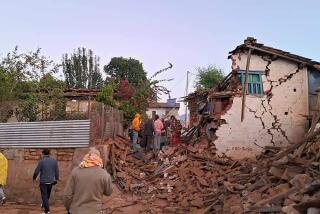Helicopters Bring Sounds of Relief
- Share via
CHAKLALA AIR BASE, Pakistan — When the earthquake struck, computer engineer Mohammed Selim immediately left work in Islamabad and headed north toward his home village of Chokathi, deep in the mountains near the center of the quake zone. But landslides had blocked the roads, so he got out of his vehicle and walked for two days -- arriving to find his brother dead and his family homeless.
Six days later, Selim was back in Islamabad, the Pakistani capital, with his injured nephew and sister, courtesy of a U.S. Army Chinook helicopter.
“There are no trucks because there are no roads,” he said Friday. “We need everything: flour, rice, vegetables, tents, medicine. I’ve seen 10 or 20 helicopters fly by. We need hundreds.”
From the first hours after the magnitude 7.6 earthquake Saturday, helicopters have crisscrossed the skies over the Pakistani-held portion of Kashmir, forming a vital link to mountain villages cut off from the world. A multinational group of chopper pilots and crews is operating out of the Chaklala air base on the outskirts of Islamabad, running a steady series of identical missions ferrying supplies in and casualties out.
“Without helicopters, we can’t do anything,” said Pakistani air force Sgt. Wazeer Ahmed.
For residents of villages such as Chokathi, remote under even the best of circumstances, the distant whump-whump of chopper blades signals the arrival of desperately needed relief. Some villagers have even taken to creating their own fake landing pads -- makeshift circled-H markers -- hoping to lead chopper pilots to believe that their village is a scouted and approved landing zone.
“I think half the bags of flour we’ve dropped have been used to make Hs and circles,” said Army Lt. Col. Wiley Thompson of the 12th Aviation Brigade, which is at the heart of the international helicopter contingent.
A total of 30 foreign transport helicopters run from Chaklala, squeezing in as many missions as possible each day before sunset.
The Army is supplying two Black Hawks and five massive twin-rotor Chinooks sent from Afghanistan. Four more helicopters have been provided by the fledgling Afghan air force, whose presence, brigade commander Col. Mark J. McKearn said, is “very symbolic.”
Through Friday, the foreign contingent had run 131 sorties, ferrying 392,000 pounds of supplies and more than 1,000 casualties.
The Pakistani air force has a fleet of about 65 helicopters, but few of them are “heavy lifters” like the Chinooks and Black Hawks. So a natural division of labor has emerged: the foreign choppers carry massive shipments of supplies to central collection points in cities and towns of the Pakistani-held portion of Kashmir, such as Muzaffarabad and Rawalakot. From there, the Pakistani aircraft take over, fanning out to remote mountaintops and secluded valleys.
“We’re now pushing into the deeper areas,” said Maj. Gen. Javed Aslam Tahir, the Pakistani army’s aviation commander. In areas too remote or hilly for a helicopter landing, crews hover to drop boxes of tents, blankets and food.
Still, Tahir estimated as much as 15% of the quake-stricken area had yet to receive relief.
On Friday morning, a Chinook took off carrying a load of tents and blankets. The short trip north to a small airfield in Rawalakot was uneventful and there was no sign of destruction in tin-roofed homes scattered among lush soaring mountains and terraced fields.
After the crew unloaded its cargo in Rawalakot and continued north, however, the scope of the disaster began to emerge. At first, the crew members saw quake-flattened houses only here and there. Then they came upon one area where half of the homes were destroyed and, finally, hillsides where all of the structures were in ruins.
The helicopter landed at a remote field hospital near Chokathi village, where a group of Pakistani army officers and a ring of barbed wire kept villagers from rushing the craft.
After receiving the all-clear signal, villagers rushed wounded relatives onto the chopper, many borne on makeshift stretchers. Men cradled bandaged babies; elderly women were carried on villagers’ backs.
At least 50 injured people were packed inside the helicopter, turning it into a gallery of victims with dazed faces and crude bandages reeking of antiseptic.
The helicopter was on the ground for 10 minutes and back in Islamabad two hours after it left, reloading for the next flight.
But it doesn’t always go that smoothly.
Earlier in the week, McKearn’s Black Hawk landed on a white circled-H. Within a minute, the crew knew something wasn’t right: There was no sign of Pakistani soldiers, just an eager crowd of villagers standing far too close to the landing pad.
“Next thing you know, they bum-rushed the aircraft.... They just poured in,” said McKearn, a native of Beloit, Wis., who wryly dubbed the incident a “humanitarian ambush.”
For several minutes, the outnumbered crew struggled to offload relief supplies while keeping desperate villagers out of the path of the helicopter’s rear rotor. Finally a Pakistani army officer on board started yelling for the crew members to leave.
They pushed out most of the remaining supplies and beat a quick retreat, but not before three villagers managed to make it onto the craft.
That and other incidents have left the helicopter crews increasingly wary and mindful of the level of desperation taking hold in Kashmir.
More to Read
Sign up for Essential California
The most important California stories and recommendations in your inbox every morning.
You may occasionally receive promotional content from the Los Angeles Times.













